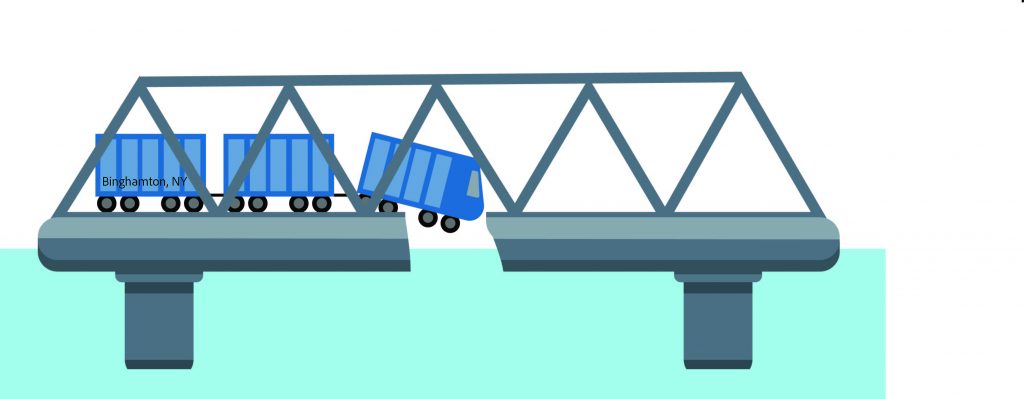A new 900-page report found that the majority of railroad bridges in Binghamton are in either poor or severe condition.
The report, released to the public in August, was commissioned by the city earlier this year in response to decades of alleged maintenance neglect by the private railroad companies who own the decaying bridges. The vast majority of Binghamton’s 28 railroad bridges are owned by either Norfolk Southern or New York Susquehanna & Western.
To conduct the structural integrity survey, the city hired HUNT Engineers, Architects, Land Surveyors and Landscape Architect, a “multidiscipline design firm,” to perform visual inspections on the structural components of each railroad bridge. Based on their observations, the four major structural classifications that inspectors could assign to bridges were good, fair, poor or severe.
In a press release, Binghamton Mayor Jared Kraham expressed concern at the report’s findings.
“This detailed and damning report confirms what residents have lived with for years,” the statement said. “Railroad companies, in particular Norfolk Southern, have failed to properly maintain bridges they own in Binghamton, leading to significant structural and safety concerns. These bridges are unsightly, crumbling and potentially dangerous.”
Unlike the maintenance of roadway overpasses, which is a government responsibility, railroad overpasses are unique, since they are owned and operated by private railroad companies. While railroads are subject to federal regulations, municipalities remain powerless to force repairs onto privately owned railway bridges, according to Megan Heiman, Binghamton’s Deputy Mayor. Heiman explained how the city ran into conflicts with railroad companies when trying to enforce maintenance of railroad overpasses.
“Residents and business owners have been concerned about the appearance of railroad bridges in Binghamton for years,” Heiman wrote in an email. “Shortly after taking office, Kraham contacted Norfolk Southern to request improvements to the bridges. The railroad company told him that without documentation of the structural problems, they wouldn’t act.”
The final report illustrates the large extent of the problem. Seven of the 22 Norfolk Southern railway bridges surveyed were found to be in severe condition, with excessive deterioration of vital support columns and exposure of steel and other materials to the exposed atmosphere. Another eight railway bridges were found to be in poor condition, with visible cracks and concrete loss present. Only three out of the 25 railway bridges surveyed were found to be in good condition.
Brett Colucciello, a sophomore majoring in biochemistry, said he was disappointed at the state of local railroad infrastructure.
“It was disturbing to read about how vital infrastructure in Binghamton is suffering from a lack of maintenance,” Colucciello said. “Something must be done. It’s very unsafe, and it hinders the prosperity of the city as a whole.”
The push for greater oversight over the maintenance of railroads comes months following the Feb. 3 derailment of a Norfolk Southern train transporting hazardous chemicals in East Palestine, Ohio. Though the cause of that derailment was most likely due to improper maintenance of the railcars, the accident has spurred heightened scrutiny over all aspects of railroad safety.
Rep. Marc Molinaro, who represents Greater Binghamton in Congress, expressed hope that the inspection findings would prevent another railroad accident in a press release.
“Railroad lines cut right through the places where families live, work and go to school,” the statement said. “We can’t let what happened in East Palestine, Ohio happen in Binghamton. I’m glad to be partnering with the city to identify the problem areas and put the pressure on to get them fixed.”
Heiman shared what policy changes are necessary to ensure safe railway infrastructure.
“The railroad companies need to act to complete necessary repairs and improvements and ensure these bridges are structurally sound,” Heiman wrote in an email. “At the federal level, policy change may be needed to ensure railroads are completing inspections as required and municipalities have full access to these inspection reports.”



